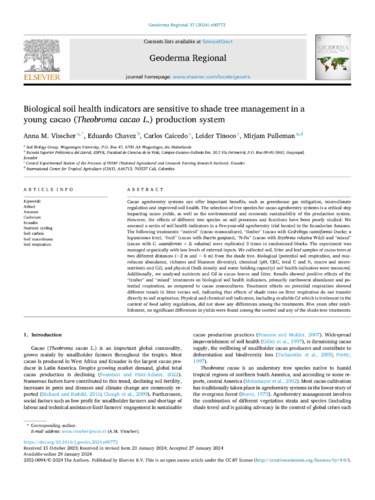Biological soil health indicators are sensitive to shade tree management in a young cacao (Theobroma cacao L.) production system
Cacao agroforestry systems can offer important benefits, such as greenhouse gas mitigation, microclimate regulation and improved soil health. The selection of tree species for cacao agroforestry systems is a critical step impacting cacao yields, as well as the environmental and economic sustainability of the production system. However, the effects of different tree species on soil processes and functions have been poorly studied. We assessed a series of soil health indicators in a five-year-old agroforestry trial located in the Ecuadorian Amazon. The following treatments: “control” (cacao monoculture), “timber” (cacao with Cedrelinga cateniformis Ducke; a leguminous tree), “fruit” (cacao with Bactris gasipaes), “N-fix” (cacao with Erythrina velutina Wild) and “mixed” (cacao with C. cateniformis + E. velutina) were replicated 3 times in randomized blocks. The experiment was managed organically with low levels of external inputs. We collected soil, litter and leaf samples of cacao trees at two different distances (~2 m and ~ 6 m) from the shade tree. Biological (potential soil respiration, and macrofauna abundance, richness and Shannon diversity), chemical (pH, CEC, total C and N, macro and micronutrients and Cd), and physical (bulk density and water holding capacity) soil health indicators were measured. Additionally, we analysed nutrients and Cd in cacao leaves and litter. Results showed positive effects of the “timber” and “mixed” treatments on biological soil health indicators, primarily earthworm abundance and potential respiration, as compared to cacao monocultures. Treatment effects on potential respiration showed different trends in litter versus soil, indicating that effects of shade trees on litter respiration do not transfer directly to soil respiration. Physical and chemical soil indicators, including available Cd which is irrelevant in the context of food safety regulations, did not show any differences among the treatments. Five years after establishment, no significant differences in yields were found among the control and any of the shade tree treatments.

